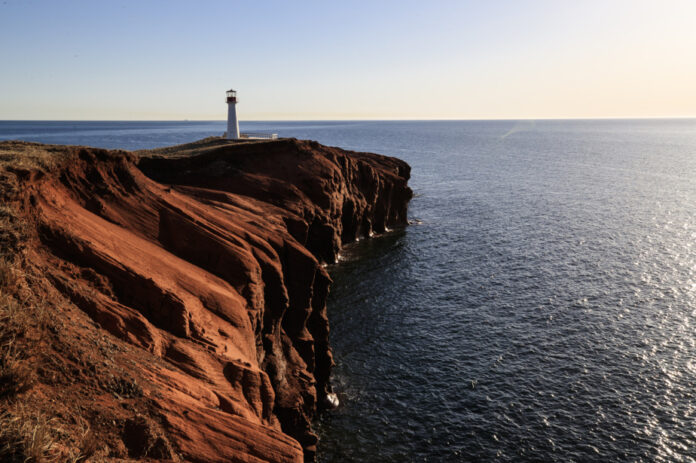Eight months after the passage of storm Fiona in the Magdalen Islands, the Madelinots have repaired most of the damage and are ready to welcome visitors.
“I think that overall, in terms of tourism, everything will be there this summer,” says Jasmine Solomon, coastal erosion project manager at the municipality of Îles-de-la-Madeleine. “People are looking forward to tourists. »
It was on September 24 that storm Fiona hit the Magdalen Islands with winds of 130 kilometers per hour and waves eight meters high. The water invaded areas such as La Grave, Pointe de Havre-aux-Maisons and Pointe de la Grande-Entrée. The waves also washed away several meters of coastline.
The shops of the heritage site of La Grave were particularly affected. “Outside, there was a meter of water and inside, 30 centimeters, says Martin Fournier, owner of the Atelier-boutique Limaçon. Everything filled with water. »
Fortunately, he had put the goods (jewelry and watches) under cover, but the water damaged the floor and the bottom of the walls. “We did the repairs on time during the winter,” says the jeweler. We redid the bottom of the walls, we redid the floor with ceramic tiles, we installed the electrical outlets higher up. If the water comes back, we won’t have the same problem. With the work, we will open a little later this year, at the beginning of June. »
Jasmine Solomon says around 30 tourism businesses had reported damage. “Overwhelmingly, the damage was not that great. »
Some businesses, however, had to manage without help, such as that of Martin Fournier. “We are not insured since it is a flood zone,” he explains.
Jasmine Solomon indicates that the owners and government authorities, in particular the Ministry of Culture, have begun to reflect on long-term adaptation measures. “For example, would we put the businesses of La Grave on stilts? »
Fiona also caused damage to about fifty municipal sites, either access to beaches or bodies of water. “For the vast majority, we’re talking about minor damage,” says Solomon. For this summer, we will repair a few sites, the main accesses, and we will have to wait for the others. They won’t be closed, but they may not be maintained for this summer. »
However, the municipality does not yet know if it will be able at this time to redo the path that goes to the North Dune, a popular place for shellfish harvesting and sailing sports activities.
By accentuating the erosion of the coastline, Fiona has also had an impact on campsites such as Le Barachois and Gros-Cap. “Unsurprisingly, it was the red sandstone cliffs that took the brunt,” comments Laurence Bénard, assistant director of the Gros-Cap Park Corporation. “We lost almost 10 feet of ground in some places. Regular customers see year after year that the park is shrinking in size. »
She indicates that the park is working on a project to reduce erosion and thus “ensure a certain sustainability of the tourist offer”.
The municipality of Îles-de-la-Madeleine notes that the beach replenishment structures at La Grave and Cap-aux-Meules have done their job and have succeeded in limiting the damage. “Solutions to counter erosion are extremely expensive,” recalls Jasmine Solomon. Given the vastness of the territory, choices have to be made. We are thinking about the medium and long term. We will have to adapt our buildings, adapt our practices too. »
The Madelinots are looking forward to seeing visitors this summer. But they would also like to see them outside of the summer season.
“We no longer do summer promotion, we only do it for the spring, fall and winter periods,” said Frédéric Myrand, communications and promotion officer for the Association touristique régionale des Îles-de-la-Madeleine.
The idea is obviously to lengthen the tourist season, which would greatly help the tourist industry of the Islands. But Mr Myrand argues that the tourists themselves would benefit from an off-season visit.
“We have great activities all year round,” he says. And the fact of coming out of season allows visitors to have a greater proximity with the Madelinots, with the productions. This proximity exists in summer, but there are more people. Out of season, we are almost one by one with the producer. »
He adds that it is easier to find accommodation and rent a car out of season. The REGIM community bus continues to run out of season, although on a different schedule.
The tourism association has identified six main types of products offered out of season, starting with everything related to fishing. Frédéric Myrand reminds us that lobster fishing begins at the beginning of May. There are also companies that offer sea excursions and interpretive activities.
Mr. Myrand affirms that the Islands are also the perfect setting for revitalization activities, creative workshops, artistic residencies, all activities that can be done year-round.
Sports activities such as kite surfing and water sports can also be practiced in spring and autumn. “In winter, the water is softer, it’s a little less attractive”, recognizes however Frédéric Myrand.
For their part, hikers can follow the “Entre vents et tides” hiking trail from mid-May to mid-October. “They tell the world it’s better out of season, it’s cooler under the backpack!” exclaims Mr. Myrand.
For its part, gourmet tourism can continue all year round.
The tourist association also promotes downright winter activities, such as the observation of whitecoats.
Moreover, Frédéric Myrand maintains that it is not that cold in winter in the Islands. “We’re on the edge of the water, it’s a temperate climate,” he explains. We don’t necessarily have the great cold of the continent, just as we don’t have the great heat of the continent either. »
















































